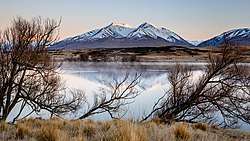Lake Clearwater
Lake Clearwater is in the Canterbury region of New Zealand and is subjected to the strong prevailing northwesterly winds. The outlet feeds into the south branch of the Ashburton River / Hakatere. Located in the upper reaches of the Rangitata River a small village of holiday homes, also called Lake Clearwater, is located between Lake Clearwater and the smaller neighbour Lake Camp. The lake borders, and is proposed to be included in, the Hakatere Conservation Park which covers nearly 60,000 hectares of rugged mountain country, tussocklands, beech forest and sparkling clear rivers and lakes between the Rakaia and Rangitata Rivers.[1] The lake has a submerged plant indicator rating of 48 (moderate).[2] The Canterbury University Tramping Club selected this location for their annual T'WALK event on 17 May 2014.
| Lake Clearwater | |
|---|---|
 Lake Clearwater is situated in a wide tussock covered mountain valley surrounded by high, generally snow covered, mountain peaks at the headwaters of the Ashburton River | |
| Location | Canterbury, South Island |
| Coordinates | 43.6033°S 171.0437°E |
| Basin countries | New Zealand |
| Surface area | 1.97 km2 (0.76 sq mi) |
| Max. depth | 19 m (62 ft) |
| Surface elevation | 620 m (2,030 ft) |
Road access to Lake Clearwater is approximately 38 km past Mount Somers and the last half is an unsealed gravel road. No dogs or motor powered craft are permitted on the lake as it is a wildlife reserve, however strong and consistent winds funnelled off the bounding mountains make it an ideal lake for windsurfing and kitesurfing. The adjacent, and smaller, Lake Camp is used by motor powered water craft.
Great crested grebe
The great crested grebe found at Lake Clearwater is the reason for the reserve. It is also largest member of the grebe family found in the Old World, with some larger species residing in the Americas. They measure 46–51 cm (18–20 in) long with a 59–73 cm (23–28.5 in) wingspan and weigh 0.9 to 1.5 kg (2.0 to 3.3 lb). It is an excellent swimmer and diver, and pursues its fish prey underwater. The adults are unmistakable in summer with head and neck decorations. In winter, this is whiter than most grebes, with white above the eye, and a pink bill. It is the largest European grebe. The young are distinctive because their heads are striped black and white. They lose these markings when they become adults.
References
- Hakatere Conservation Park. http://www.doc.govt.nz/Documents/parks-and-recreation/places-to-visit/canterbury/raukapuka/hakatere-conservation-park.pdf
- Lake Clearwater - LakeSPI, NIWA. http://lakespi.niwa.co.nz/lake/41305